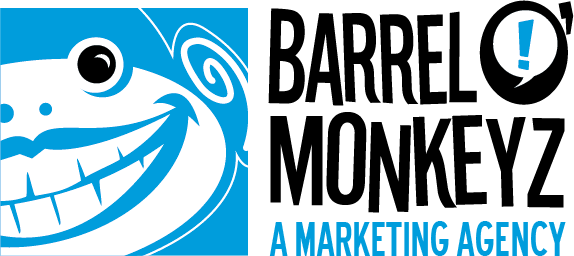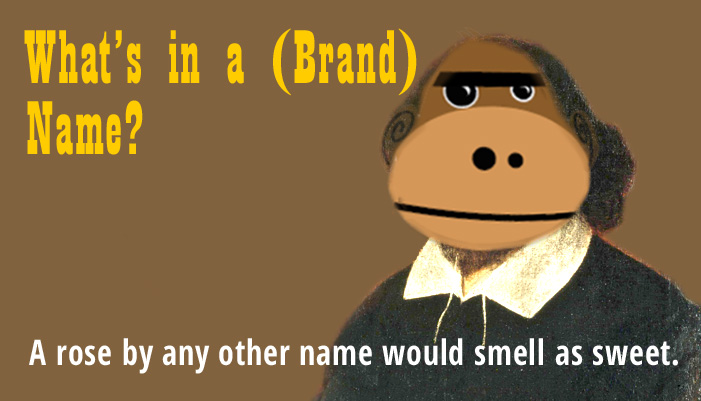I get asked all the time where I came up with the name “Barrel O’Monkeyz.”
I’ve always been intrigued by monkeys. They always seem to be having fun. Monkeys make me laugh. And that’s a big part of who I am . . . and the kind of organization I wanted my company to be. Life’s too short not to have fun!
Monkeys are also a diverse bunch. They come in all shapes and sizes, with different talents, different attributes, and unique personalities, and that was just the kind of team I wanted to build and the kind of clientele I wanted to serve.
From there, the idea of all these monkeys being in a barrel, wasn’t a big leap. No doubt its roots came from the saying, “having more fun than a barrel of monkeys,” which is self-explanatory (because, let’s face it, who could ever have more fun than a barrel of monkeys?)—but I also liked the idea of being in something together, which really connected with my fondness of teamwork, collaboration, and camaraderie.
That said, let’s turn the web pages back a few years to a blog I wrote entitled, “Branding: If It Looks Like a Duck, Swims Like a Duck . . .,” which explored how your brand story lays the foundation for everything you are and will be as a business. Here it is again. Enjoy!
Branding: If It Looks Like a Duck, Swims Like a Duck . . .
(Originally posted April 10, 2012 by Paul June)
Back in 1600, when Shakespeare penned Juliet’s now-famous line “What’s in a name? That which we call a rose by any other name would smell as sweet,” I doubt he ever imagined it would be used in a 2012 business blog about “branding.” But here it is. And with my sincere apologies to The Great Bard, I find his words a perfect way to underscore my thoughts on branding: what matters most is what a business or person “is,” not what it (or he or she) is called.
Sure, there’s bound to be some “cachet” in the naming of a product or brand. For example, would you prefer to drive a “Jaguar” or a “Housecat”? You get the idea. A brand is more than a few words and your logo. Your brand is a story that lays the foundation for everything you are and will be as a business.
Now, fast forward to modern times where the immortal words, “If it looks like a duck, swims like a duck, and quacks like a duck, then it probably is a duck,” suggest something quite the same. The sum total of what something “is”—the way it looks, acts, and behaves—is, well, what it “is” regardless of what you call it. And that’s how building a brand works: it’s not just what you say about yourself (“I’m a duck”), it’s how you act and behave and are perceived.
What promises does your business make to customers, and do you deliver? Is your business an upstanding member of the community? Are you socially responsible? Do you “play nice” with others? Do you pay it forward? All these things and more contribute to your brand—the perception of what your business stands for and what you’re all about in the minds of consumers.
Strategic branding is the foundation from which all effective communications about your business should originate. Everything your company says or does at any level—whether you’re a solo entrepreneur of a global organization—should reinforce who you are, what you promise, and the “place” you want to occupy in the minds and hearts of consumers.
You don’t know what that place is, you say? Well, you’re not alone. Most companies, especially small businesses and solo entrepreneurs never go through a bona-fide strategic branding process. “We’re too small,” they say. “It costs too much. We just need a logo and a catchy slogan.”
Let me caution anyone who thinks this way: willy-nilly branding practices are dangerous. Whether you realize it or not, your brand IS a highly valued business asset—both on the balance sheet and in the minds of the market. And for many solo professionals, their brand—who they are and how they’re perceived (they’re reputation in the marketplace)—is often the biggest (if not only) asset they have. And a good reputation sullied or miscommunicated is VERY difficult to rebuild.
Big or small, you should NOT communicate your brand until you know exactly who you are, what your business is all about, and why you matter. Impulsive branding brainstorms—influenced chiefly by emotion, subjectivity, and “gut instinct” (and often conducted internally without input from outside audiences)—can hazardously define an organization’s present and future for better or worse.
You need to take the time to build a solid brand strategy from which all your communications can grow clearly, concisely, and consistently. At Barrel O’Monkeyz, we urge clients to ask “How can you know where you are going, if you don’t know where you are?”
- What are your guiding principles?
- What does your company stand for?
- What’s your corporate culture?
- What do you offer clients and customers that they can’t live without or get somewhere else?
- What does your target audience expect from you?
- How do you WANT to be perceived (and if you’re not where you’d like to be, how can we get you there)?
With a solid brand strategy in hand, and the commitment to deliver on your promises, you can demonstrate your brand to the world—the sum total of who and what you are—with confidence through coordinated marketing and communications efforts, advertising, PR, packaging, social media, digital assets, content, and more.
How did you build your brand? How do you continue building and reinforcing it every day?
Share your experiences and guidance here.
Paul June is King Monkey of BARREL O’MONKEYZ, a full-service digital media and marketing group specializing in more creativity, ideas, and fun for action sports marketing, sportswear marketing, sports product marketing, active lifestyle consumer products, health product marketing, and brands in San Diego and Southern California.

